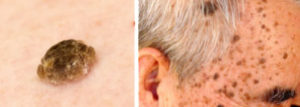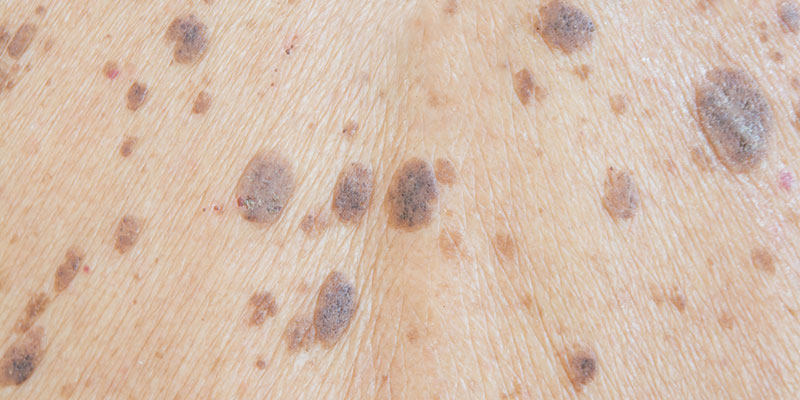What Are These Brown, Rough Moles on My Skin?
Any time you notice a suspicious spot on your skin, it is a good idea to see your dermatologist for an accurate diagnosis and treatment recommendations. You can find a board certified dermatologist at AAD.org. While you are on the lookout for suspicious moles, you might come across a scarey looking skin lesion called seborrheic keratosis or “SK”. Here are a few of the differences between a mole, skin cancer and seborrheic keratosis, and what you can do to get rid of these lesions.
How Can I Tell What Moles Are Cancerous?
There are 3 main types of skin cancer. Click here to read a blog about skin cancer. Melanoma is the deadliest form of skin cancer and is the most likely to be confused with seborrheic keratosis. It is always best to have a dermatologist check your moles, but you should be familiar with warning signs of melanoma. These are known as the ABCs and if present mean that the lesion is more likely to be a deadly melanoma and should be removed immediately. A- Asymmetry- If a line were drawn through the center of the mole, the two sides would not be mirror image of each other. B- Border- The borders of melanoma are indistinct and it is hard to tell where the lesion begins. C- Color- Melanomas often have dark black or dark brown areas with lighter white, grey and blueish areas. D- Diameter- Lesions that are larger than a cm are more worry some but I have seen many melanomas the size of a pin point so this is not reliable.These are images of melanomas
These are images of melanomas

What Is Seborrheic Keratosis?
Seborrheic keratosis, commonly referred to as simply “SK”, is a type of benign (noncancerous) skin growth that can resemble a rough, bumpy wart. In most cases, these growths will begin as a smaller lesion that may be itchy and rough. SK is not a medical concern but as these lesions grow larger, they become itchier and uglier so many people choose to have them removed. These lesions are considered to be cosmetic issues and their removal is not covered by insurance. SK is most likely to occur on areas of the skin that are frequently exposed to the sun, such as your face, chest, and shoulders, although they can appear anywhere on the body. It is also likely that genetics play at least some role in the development of SK, so if your parents have these spots on their skin, the chances that you will too. Wearing daily sun protection may help prevent the development of SKs.
How to Tell the Difference between SK and Moles
Seborrheic keratosis often resembles other common skin lesions, such as moles, actinic keratosis, and even melanomas. The main characteristic that sets them apart, though, is that SK typically has a waxy, warty look and a rough texture whereas other skin lesions tend to be smoother and more uniform in texture (American Academy of Dermatology). SKs develop at the surface of the skin and can be picked and scratched off in many cases. However, they rapidly regrow if not removed properly.

These are SK Lesions Because SK can be so difficult to distinguish from other potentially more harmful skin lesions, you should see your dermatologist if you notice any major changes to moles or SKs just to be sure. Click here to learn more about SKs.
How to Get Rid of Seborrheic Keratosis
Although seborrheic keratosis isn’t dangerous and is considered cosmetic, it is best to have these lesions removed when they are smaller. This is because the bigger they grow, the larger the risk of a scar when they are removed. SKs can become itchier and protrude from the skin’s surface and be snagged on clothing and jewelry. They will get bigger and uglier with time. There are two main ways that your dermatologist might suggest for removing these lesions.
- Cryotherapy- Freezing them off using liquid nitrogen. You may experience some slight stinging during this procedure, but the lesion will instantly freeze. Over the next day the area will blister and in 2-3 days a scab will form where the liquid nitrogen was sprayed. After about 3-6 weeks, the scab should fall off on its own, which should also remove your seborrheic keratosis (Mayo Clinic). In many cases it will take 3-5 treatments to completely remove these stubborn lesions. Over freezing them can lead to depigmented areas of skin, white marks and scars, so a doctor concerned with the cosmetic outcome will treat these slowly over a few visits. Cryotherapy may be combined with curettage to speed resolution.
- Chemical peel – Trichloroacetic acid (TCA) can be applied to the SK. This will also leave a scab for a few weeks and may take 3-6 treatments. Scarring can result but is not very likely when TCA is used properly.
- Laser- Laser ablates the area leaving a scab in the area that the SK was. This usually requires one treatment but can be expensive. Scarring is possible.
- Hyfrecation- Using an electric needle to burn the SK. This is painful but usually only requires one treatment. Scarring is possible.
A few pointers to keep in mind if you’re getting SKs removed are to:
- Keep your skin protected from the sun, even after they are removed. Sun exposure can cause the treated area to become discolored.
- It may take two or three treatments to fully remove the lesion
- Each treatment session generally costs about $100 to $500 depending on the methodology used. Unfortunately, unless your SK is infected or otherwise deemed a medical concern, insurance won’t cover the cost of removal.
- Once you have one SK, you’re likely to develop more.
- Be checked every six months to catch them early and to make sure that they are not skin cancer.
In Summary
Staying on top of your skin’s health by performing a self-exam and seeing your dermatologist at least once a year is an excellent habit that might save your life. Catching SKs early makes the removal much easier and the chance of skin pigment changes and scarring much less.
Dr. Leslie Baumann, M.D. and her team at Baumann Cosmetic Dermatology believe in proof, not promises. World-recognized for both cosmetic and general dermatology, our treatment strategies rely exclusively on evidence-based, scientifically verified products and procedures that promote skin health and a natural appearance. We combine effective medical procedures with individualized instruction on proper skincare, nutrition, supplementation and lifestyle in order to maximize the health of the skin and body as a whole while minimizing the effects of aging. For more, visit Dr. Baumann’s blog for daily updates Monday through Friday, or inquire about an appointment through Derm.net.



